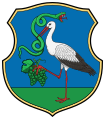Gyöngyös
Gyöngyös | |
|---|---|
 Orczy palace of Orczy family | |
| Country | |
| County | Heves |
| Area | |
• Total | 54.1 km2 (20.9 sq mi) |
| Population (2001) | |
• Total | 33,553 |
| • Density | 620/km2 (1,600/sq mi) |
| Time zone | UTC+1 (CET) |
| • Summer (DST) | UTC+2 (CEST) |
| Postal code | 3200 |
| Area code | 37 |
Gyöngyös [ˈɟøɲɟøʃ] is a town in Heves county in Hungary, 80 km (50 mi) east of Budapest. Situated at the foot of the Sár-hegy and Mátra mountains, it is the home of numerous food production plants, including milk production and sausage factories. It is also the home of many vineyards on the slopes of the Sárhegy.
The Art-Nouveau and Baroque buildings around the main square were reconstructed after a disastrous fire started in the local hospital in 1917,[1] destroying a number of buildings housing important Jewish institutions and leaving in all around 8,000 homeless.[2]
Name

The meaning of the town's name is "Made of Pearls" (pronounced as "Dyun-dyush"). The 16-17th century historian Miklós Istvánffy wrote that the name of the town comes from the Hungarian word for mistletoe (fagyöngy literally "wood-pearl"), which is abundant in the local woods. Croats from Hungary call this city Đunđuš.
Sights to visit
There are many monuments and places of interest in the town, such as the Orczy mansion, home of the Mátra Museum, Saint Bartholomew's Church (Saint Bartholomew Church, Gyöngyös, Hungary) in the center of town, and its Treasury.
Famous people
Gyöngyös is the birthplace of Olympic swimmer Gabriella Csépe, the well-known sociologist and conference organiser Gyöngyi Horváth, and the leader of the Jobbik Movement for a Better Hungary, Gábor Vona.
Jewish Field Marshal Edward Ritter Von Schweitzer was born here in 1844. His military and philanthropic endeavors are well recalled in several publications.
International relations
Twin towns — Sister cities
Gyöngyös is twinned with:
 Pieksämäki, Finland
Pieksämäki, Finland Ringsted, Denmark
Ringsted, Denmark Sanok, Poland
Sanok, Poland Shusha, Azerbaijan[3] (de facto, Nagorno-Karabakh Republic)
Shusha, Azerbaijan[3] (de facto, Nagorno-Karabakh Republic) Târgu Secuiesc, Romania
Târgu Secuiesc, Romania Zeltweg, Austria
Zeltweg, Austria
Gallery
-
Aerial photograph of the water tower, built in 1927.
References
- ^ Charles Hebbert, Norm Longley, Dan Richardson (2002). Hungary (Rough Guide Travel Guides). Rough Guides Ltd. p. 323. ISBN 1-85828-917-3.
{{cite book}}: CS1 maint: multiple names: authors list (link) - ^ Adrian Phillips, Jo Scotchmer (2010). Bradt Travel Guides. Hungary. p. 222. ISBN 1-84162-285-0.
- ^ A declaration of fraternization between Gyöngyös, at the foot of the Mátra, the highest mountain range in Hungary, and the occupied Shusha town of Azerbaijan.
External links
- Gyöngyös Template:Hu icon at gyongyos.info
47°47′N 19°56′E / 47.783°N 19.933°E




